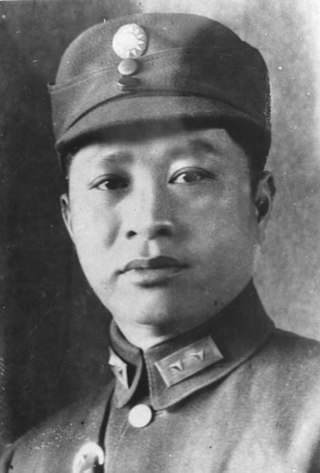
The Chinese Buddhist canon refers to a specific collection of Chinese language Buddhist literature that is deemed canonical in Chinese, Japanese, Korean and Vietnamese Buddhism. The traditional term for the canon is "Great Storage of Scriptures".

Uskhal Khan, also called the Last Lord of Northern Yuan or by his era name the Tianyuan Emperor, born Tögüs Temür, was an emperor of the Northern Yuan dynasty, reigning from 1378 to 1388. He was the last powerful khagan of the Mongols until Dayan Khan.

Ye Ting, born in Huiyang, Guangdong, was a Chinese military leader who played a key role in the Northern Expedition to reunify China after the 1911 Revolution. After serving with the Kuomintang, Ye later joined the Communist Party of China (CPC).

Wenshu Guangfa Tianzun is a Taoist deity and character in the classic Chinese novel Investiture of the Gods. He is a disciple of Yuanshi Tianzun and one of the Three Great Immortals, holding the fifth position among the Twelve Golden Immortals.

Cihang Zhenren is a Daoist deity and character in the classic Chinese novel Investiture of the Gods. He is a disciple of Yuanshi Tianzun and one of the Three Great Immortals, holding the ninth position among the Twelve Golden Immortals.

Zhan Furui is a former National Librarian of China and a literary critic.

Pingtan, also known as Suzhou pingtan, is a regional variety of quyi and a musical/oral performance art form popular in southern Jiangsu, northern Zhejiang, and Shanghai. It originated in the city of Suzhou. It is a combination of the Chinese narrative musical traditions pinghua and tanci. It dates back to Song dynasty and is influenced by Wuyue culture.
The Taishang Ganying Pian (太上感應篇), or Lao Tse's Treatise on the Response of the Tao, is a Taoist scripture from the 12th century that has been very influential in China. Li Ying-Chang, a Confucian scholar who retired from civil administration to teach Taoism, authored this. It is traditionally attributed to Lao Tse himself.
Tham Yew Chin, known by her pseudonym You Jin (尤今), is a Singaporean writer. She received the Cultural Medallion Award in 2009 for her contributions to Singapore's literary arts scene.

The People's Literature Publishing House is a large-scale publishing house in China. It was established in March 1951, and was attached to the China Publishing Group. It is known for scholarly publications, editions of classical Chinese literature, dictionaries, and high-quality paperbacks. Its head office is at Chaoyangmen 116, Beijing. Its current director is Pan Kaixiong and the editor-in-chief is Guan Shiguang.

Liu Bingyan (1915–1998) was a People's Republic of China politician. He was born in Hebei. He was governor of his home province. He was a delegate to the 1st National People's Congress, 5th National People's Congress and 6th National People's Congress.
Khön clan of Sakya is a Tibetan clan and nobility originally based in Sa'gya. The clan traces its history to the time of Bod Chen Po. The Sakya Trizin of Sakya school was exclusively chosen from members of this clan. The current head of Khön clan is Gyana Vajra Rinpoche.

The Yongling Mausoleum, commonly known as the tomb of Wang Jian, is the burial place of Wang Jian (847–918), the founding emperor of Former Shu. It is located at 10 Yongling Road, Jinniu District, Chengdu, Sichuan, China.

Aisin Gioro Yunxi was Kangxi Emperor's 21st surviving son and the first Prince Shen of the Second Rank. Due to his age, Yunxi was not embroiled in the succession war among Kangxi Emperor's sons. Yunxi belonged to the most notable artists of the Qing dynasty.

Emperor Xiyue is a Taoist deity of the sacred mountain Mount Hua and one of the Great Emperor of Five Mountains. It is said that the worship of Xiyue Dadi can be traced back to the Shang dynasty when he was revered as the ancestor of Dayu. In the period of Emperor Wu of the Han Dynasty, a large-scale sacrificial temple was constructed for Xiyue Dadi as a gesture of respect towards this deity. Xiyue Dadi is the father of Huashan Erlang, Huashan Sanlang and Huayue Sanniang.
The Xiapu Manichaean manuscripts are Chinese Manichaean manuscripts from Shangwan Village 上万村, Baiyang Township, Xiapu County, Fujian Province, China. They first became known to academia and the general public in October 2008. Today in Baiyang Township, the texts are used for rituals conducted for Lin Deng 林瞪 in the three villages of Baiyang 柏洋村, Shangwan 上万村, and Tahou 塔后村.
Empress Xiancheng, of the Yeli clan, was a Western Xia empress as the first empress of Emperor Jingzong.
Guan Zhaozhi was a Chinese mathematician. He was a member of the Chinese Academy of Sciences.
Huang Zuqia was a Chinese theoretical and nuclear physicist, born in Changsha, Hunan province who was elected as a member of the Chinese Academy of Sciences in 1980. He made significant contributions to the theoretical design of China's hydrogen bombs.











